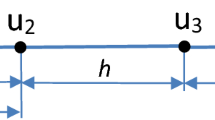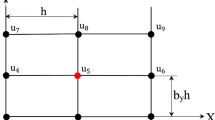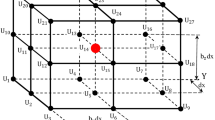Abstract
A new numerical approach for the time-dependent wave and heat equations as well as for the time-independent Poisson equation developed in Part 1 is applied to the simulation of 1-D and 2-D test problems on regular and irregular domains. Trivial conforming and non-conforming Cartesian meshes with 3-point stencils in the 1-D case and 9-point stencils in the 2-D case are used in calculations. The numerical solutions of the 1-D wave equation as well as the 2-D wave and heat equations for a simple rectangular plate show that the accuracy of the new approach on non-conforming meshes is practically the same as that on conforming meshes for both the Dirichlet and Neumann boundary conditions. Moreover, very small distances (\(0.1 h - 10^{-9}h\) where h is the grid size) between the grid points of a Cartesian mesh and the boundary do not decrease the accuracy of the new technique. The application of the new approach to the 2-D problems on an irregular domain shows that the order of accuracy is close to four for the wave and heat equations and is close to five for the Poisson equation. This is in agreement with the theoretical results of Part 1 of the paper. The comparison of the numerical results obtained by the new approach and by FEM shows that at similar 9-point stencils, the accuracy of the new approach on irregular domains is two orders higher for the wave and heat equations and three orders higher for the Poisson equation than that for the linear finite elements. Moreover, the new approach yields even much more accurate results than the quadratic and cubic finite elements with much wider stencils. An example of a problem with a complex irregular domain that requires a prohibitively large computation time with the finite elements but can be easily solved with the new approach is presented.


























Similar content being viewed by others
References
Angel, J.B., Banks, J.W., Henshaw, W.D.: High-order upwind schemes for the wave equation on overlapping grids: Maxwell’s equations in second-order form. J. Comput. Phys. 352, 534–567 (2018)
Assêncio, D.C., Teran, J.M.: A second order virtual node algorithm for stokes flow problems with interfacial forces, discontinuous material properties and irregular domains. J. Comput. Phys. 250, 77–105 (2013)
Bedrossian, J., von Brecht, J.H., Zhu, S., Sifakis, E., Teran, J.M.: A second order virtual node method for elliptic problems with interfaces and irregular domains. J. Comput. Phys. 229(18), 6405–6426 (2010)
Burman, E., Hansbo, P.: Fictitious domain finite element methods using cut elements: I. A stabilized lagrange multiplier method. Comput. Methods Appl. Mech. Eng. 199(41–44), 2680–2686 (2010)
Chen, L., Wei, H., Wen, M.: An interface-fitted mesh generator and virtual element methods for elliptic interface problems. J. Comput. Phys. 334, 327–348 (2017)
Colella, P., Graves, D.T., Keen, B.J., Modiano, D.: A cartesian grid embedded boundary method for hyperbolic conservation laws. J. Comput. Phys. 211(1), 347–366 (2006)
Crockett, R., Colella, P., Graves, D.: A cartesian grid embedded boundary method for solving the poisson and heat equations with discontinuous coefficients in three dimensions. J. Comput. Phys. 230(7), 2451–2469 (2011)
Dakin, G., Despres, B., Jaouen, S.: Inverse lax-wendroff boundary treatment for compressible lagrange-remap hydrodynamics on cartesian grids. J. Comput. Phys. 353, 228–257 (2018)
Fries, T., Omerović, S., Schöllhammer, D., Steidl, J.: Higher-order meshing of implicit geometries–part i: integration and interpolation in cut elements. Comput. Methods Appl. Mech. Eng. 313, 759–784 (2017)
Hellrung, J.L., Wang, L., Sifakis, E., Teran, J.M.: A second order virtual node method for elliptic problems with interfaces and irregular domains in three dimensions. J. Comput. Phys. 231(4), 2015–2048 (2012)
Hoang, T., Verhoosel, C.V., Auricchio, F., van Brummelen, E.H., Reali, A.: Mixed isogeometric finite cell methods for the stokes problem. Comput. Methods Appl. Mech. Eng. 316, 400–423 (2017)
Idesman, A.: A new numerical approach to the solution of PDEs with optimal accuracy on irregular domains and Cartesian meshes. Part 1: the derivations for the wave, heat and Poisson equations in the 1-D and 2-D cases. Arch. Appl. Mech., 1–31 (2020). https://doi.org/10.1007/s00419-020-01744-w
Idesman, A.V.: Accurate time integration of linear elastodynamics problems. Comput. Model. Eng. Sci. 71(2), 111–148 (2011)
Idesman, A.V., Samajder, H., Aulisa, E., Seshaiyer, P.: Benchmark problems for wave propagation in elastic materials. Comput. Mech. 43(6), 797–814 (2009)
Idesman, A.V., Pham, D., Foley, J., Schmidt, M.: Accurate solutions of wave propagation problems under impact loading bythe standard, spectral and isogeometric high-order finite elements.comparative study of accuracy of different space-discretization techniques. Finite Elem. Anal. Des. 88, 67–89 (2014)
Johansen, H., Colella, P.: A cartesian grid embedded boundary method for poisson’s equation on irregular domains. J. Comput. Phys. 147(1), 60–85 (1998)
Jomaa, Z., Macaskill, C.: The embedded finite difference method for the poisson equation in a domain with an irregular boundary and dirichlet boundary conditions. J. Comput. Phys. 202(2), 488–506 (2005)
Jomaa, Z., Macaskill, C.: The shortley-weller embedded finite-difference method for the 3d poisson equation with mixed boundary conditions. J. Comput. Phys. 229(10), 3675–3690 (2010)
Kreiss, H.O., Petersson, N.A.: A second order accurate embedded boundary method for the wave equation with dirichlet data. SIAM J. Sci. Comput. 27(4), 1141–1167 (2006)
Kreiss, H.O., Petersson, N.A., Ystrom, J.: Difference approximations of the neumann problem for the second order wave equation. SIAM J. Numer. Anal. 42(3), 1292–1323 (2004)
Kreisst, H.O., Petersson, N.A.: An embedded boundary method for the wave equation with discontinuous coefficients. SIAM J. Sci. Comput. 28(6), 2054–2074 (2006)
Mattsson, K., Almquist, M.: A high-order accurate embedded boundary method for first order hyperbolic equations. J. Comput. Phys. 334, 255–279 (2017)
May, S., Berger, M.: An explicit implicit scheme for cut cells in embedded boundary meshes. J. Sci. Comput. 71(3), 919–943 (2017)
McCorquodale, P., Colella, P., Johansen, H.: A cartesian grid embedded boundary method for the heat equation on irregular domains. J. Comput. Phys. 173(2), 620–635 (2001)
Rank, E., Kollmannsberger, S., Sorger, C., Duster, A.: Shell finite cell method: a high order fictitious domain approach for thin-walled structures. Comput. Methods Appl. Mech. Eng. 200(45–46), 3200–3209 (2011)
Rank, E., Ruess, M., Kollmannsberger, S., Schillinger, D., Duster, A.: Geometric modeling, isogeometric analysis and the finite cell method. Comput. Methods Appl. Mech. Eng. 249–252, 104–115 (2012)
Salari, K., Knupp, P.: Code verification by the method of manufactured solutions. Sandia Report, SAND 2000–1444, pp. 1–124. Sandia National Laboratories, Albuquerque, NM (2000)
Schwartz, P., Barad, M., Colella, P., Ligocki, T.: A cartesian grid embedded boundary method for the heat equation and poisson’s equation in three dimensions. J. Comput. Phys. 211(2), 531–550 (2006)
Singh, K., Williams, J.: A parallel fictitious domain multigrid preconditioner for the solution of poisson’s equation in complex geometries. Comput. Methods Appl. Mech. Eng. 194(45–47), 4845–4860 (2005)
Uddin, H., Kramer, R., Pantano, C.: A cartesian-based embedded geometry technique with adaptive high-order finite differences for compressible flow around complex geometries. J. Comput. Phys. 262, 379–407 (2014)
Vos, P., van Loon, R., Sherwin, S.: A comparison of fictitious domain methods appropriate for spectral/hp element discretisations. Comput. Methods Appl. Mech. Eng. 197(25–28), 2275–2289 (2008)
Zhao, S., Wei, G.W.: Matched interface and boundary (mib) for the implementation of boundary conditions in high-order central finite differences. Int. J. Numer. Methods Eng. 77(12), 1690–1730 (2009)
Acknowledgements
The research has been supported in part by the Air Force Office of Scientific Research (Contract FA9550-16-1-0177), by NSF (Grant CMMI-1935452) and by Texas Tech University.
Author information
Authors and Affiliations
Corresponding author
Ethics declarations
Conflict of interest
On behalf of all authors, the corresponding author states that there is no conflict of interest.
Additional information
Publisher's Note
Springer Nature remains neutral with regard to jurisdictional claims in published maps and institutional affiliations.
Appendix A. The summary of the new numerical approach developed in Part 1 of the paper.
Appendix A. The summary of the new numerical approach developed in Part 1 of the paper.
The wave and heat equations in domain \(\Omega \) can be uniformly written as:
where \(n=2\) and \(\bar{c}=c^2\) for the wave equation as well as \(n=1\) and \(\bar{c}=a\) for the heat equation, c is the wave velocity, a is the thermal diffusivity, \(f (\mathbf{x}, t)\) is the loading term and u is the field variable. The Poisson equation in domain \(\Omega \) has the following form:
The Neumann boundary conditions \(\mathbf{n} \cdot \bigtriangledown u = g_1\) on \(\Gamma ^t \) and the Dirichlet boundary conditions \(u=g_2\) on \(\Gamma ^u\) are applied where \(\mathbf{n}\) is the outward unit normal on \(\Gamma ^t\) and \(\Gamma ^t\) and \(\Gamma ^u\) denote the boundaries with the Dirichlet and Neumann boundary conditions, respectively. The initial conditions are \(u (\mathbf{x}, t=0) =g_3\), \(v (\mathbf{x}, t=0) =g_4\) in \(\Omega \) for the wave equation and \(u (\mathbf{x}, t=0) =g_3\) in \(\Omega \) for the heat equation where \(g_i\) (\(i=1,2,3,4\)) are the given functions.
1.1 Appendix A.1. The stencil equations for the 1-D wave equation
The following 3-point stencils on conforming and non-conforming uniform meshes are used:
where the case of zero loading \(f = \bar{f} = 0\) is considered below, \(A=2,\ldots ,N-1\), N is the total number of grid points (Fig. 1). The coefficients \(m_j\) and \(k_j\) (\(j=1,2,3\)) are determined in Part 1 from the minimization of the local truncation error and are given: a) by Eq. (15) of Part 1 for the internal nodes \(A=3,\ldots ,N-2\) located far from the boundary (\(\bar{f}^{Neum} =0\)); b) by Eq. (14) of Part 1 for the nodes \(A=2,N-1\) located close to the boundary with the Dirichlet boundary conditions (\(\bar{f}^{Neum} =0\)); c) by Eq. (29) of Part 1 for the nodes \(A=2,N-1\) located close to the boundary with the Neumann boundary conditions (for the Neumann boundary conditions, \(\bar{f}^{Neum} = f_1\) where \(f_1\) is determined by Eq. (30) of Part 1). The coefficients \(m_1=k_1=0\) are zero in Eq. (29) of Part 1; i.e., the 2-node stencils, Eq. (A.3) with \(m_1=k_1=0\), are used for the points located close to the boundary with the Neumann boundary conditions.
1.2 Appendix A.2. The stencil equations for the 2-D wave and heat equations
The following 9-point stencils on Cartesian meshes are used:
where \(\bar{f}_{A,B} = 0\) in the case of zero load \(f=0\) and \(\bar{f}_{A,B}\) is defined by Eq. (45) of Part 1 for nonzero load \(f \ne 0\), the superscript n in the time derivative in Eq. (A.4) and the material parameter \(\bar{c}\) are \(n=1\) and \(\bar{c}=a\) for the heat equation as well as \(n=2\) and \(\bar{c}=c^2\) for the wave equation. The coefficients \(m_j\) and \(k_j\) (\(j=1,2,\ldots ,9\)) along with the coefficients \(l_i\) (\(i=1,2,3,4\)) used for the Neumann boundary conditions (see below) are determined from the minimization of the local truncation error and are: a) given by Eq. (39) of Part 1 for the internal nodes located far from the boundary (Fig. 27) and \(\bar{f}_{A,B}^{Neum} =0\); b) calculated by the solution of 17 linear algebraic equations \(b_p=0\) for \(p=1,2,\ldots , 11,13,14,15,17,20,26\) (\(b_p\) are given by Eq. (C.1) of Part 1) for the nodes located close to the boundary with the Dirichlet boundary conditions (see Fig. 28) and \(\bar{f}_{A,B}^{Neum}=0\); c) calculated by the solution of 6 linear algebraic equations given by Eq. (52) of Part 1 (as well as Eqs. (C.2) and (A.2) of Part 1) for the nodes located close to the boundary with the Neumann boundary conditions and \(\bar{f}_{A,B}^{Neum}=\bar{c} h (l_1 g_1(x_1,y_1,t)+l_2 g_1(x_2,y_2,t)+l_3 g_1(x_3,y_3,t))+ h^3 l_4 \frac{\partial ^n g_1(x_2,y_2,t) }{\partial t^n}\) where \(x_i, y_i\) (\(i=1,2,3\)) are the coordinates of 3 boundary points (Fig. 29) and \(g_1(x_i, y_i, t)\) expresses the Neumann boundary conditions. The coefficients \(m_7=k_7=0\) for the stencil in Fig. 29 are zero; i.e., the 8-node cut stencils, Eq. (A.4) with \(m_7=k_7=0\), are used for the points located close to the boundary with the Neumann boundary conditions.
The spatial locations of the degrees of freedom \(u_{i,j}\) (\(i = A-1, A, A+1\), \(j = B-1, B, B+1\)) that contribute to the 8-point cut stencils for the internal degrees of freedom \(u_{A,B}\) and \(u_{A,B+1}\) located close to the boundary with the Neumann boundary conditions. \(\bullet \) designates the 8 nodes contributing to the stencil equation
1.3 Appendix A.3. The stencil equations for the 2-D Poisson equation
Nine-node stencils for the degree of freedom \(u^{\mathrm{num}}_{A,B}\) of the time-independent Poisson equation can be obtained from Eq. (A.4) with \(\bar{c}=1\) and \(m_j= 0\) (\(j=1,2,\ldots ,9\)) as follows:
where \(\bar{f}_{A,B} = 0\) in the case of zero load \(f=0\) and \(\bar{f}_{A,B}\) is defined by Eq. (D.1) of Part 1 for nonzero load \(f \ne 0\). The coefficients \(k_j\) (\(j=1,2,\ldots ,9\)) along with the coefficients \(l_i\) (\(i=1,2,3,4\)) used for the Neumann boundary conditions (see below) are determined from the minimization of the local truncation error and are: a) given by Eq. (58) of Part 1 for the internal nodes located far from the boundary (Fig. 27) and \(\bar{f}_{A,B}^{Neum} =0\); b) calculated by the solution of 8 linear algebraic equations \(b_p=0\) for \(p=1,2,\ldots , 8\) (\(b_p\) are given by Eq. (C.3) of Part 1) for the nodes located close to the boundary with the Dirichlet boundary conditions (see Fig. 28) and \(\bar{f}_{A,B}^{Neum}=0\); c) calculated by the solution of 11 linear algebraic equations \(b_p=0\) for \(p=1,2,\ldots , 11\) (\(b_p\) are given by Eq. (C.4) of Part 1) for the nodes located close to the boundary with the Neumann boundary conditions and \(\bar{f}_{A,B}^{Neum}=\bar{c} h (l_1 g_1(x_1,y_1)+l_2 g_1(x_2,y_2)+l_3 g_1(x_3,y_3))+ +l_4 g_1(x_4,y_4)\) where \(x_i, y_i\) (\(i=1,2,3,4\)) are the coordinates of 4 boundary points (Fig. 29), and \(g_1(x_i, y_i)\) expresses the Neumann boundary conditions. The coefficients \(k_7=0\) for the stencil in Fig. 29 are zero; i.e., the 8-node stencils, Eq. (A.5) with \(k_7=0\), are used for the points located close to the boundary with the Neumann boundary conditions.
Rights and permissions
About this article
Cite this article
Dey, B., Idesman, A. A new numerical approach to the solution of PDEs with optimal accuracy on irregular domains and Cartesian meshes—part 2: numerical simulations and comparison with FEM. Arch Appl Mech 90, 2649–2674 (2020). https://doi.org/10.1007/s00419-020-01742-y
Received:
Accepted:
Published:
Issue Date:
DOI: https://doi.org/10.1007/s00419-020-01742-y







